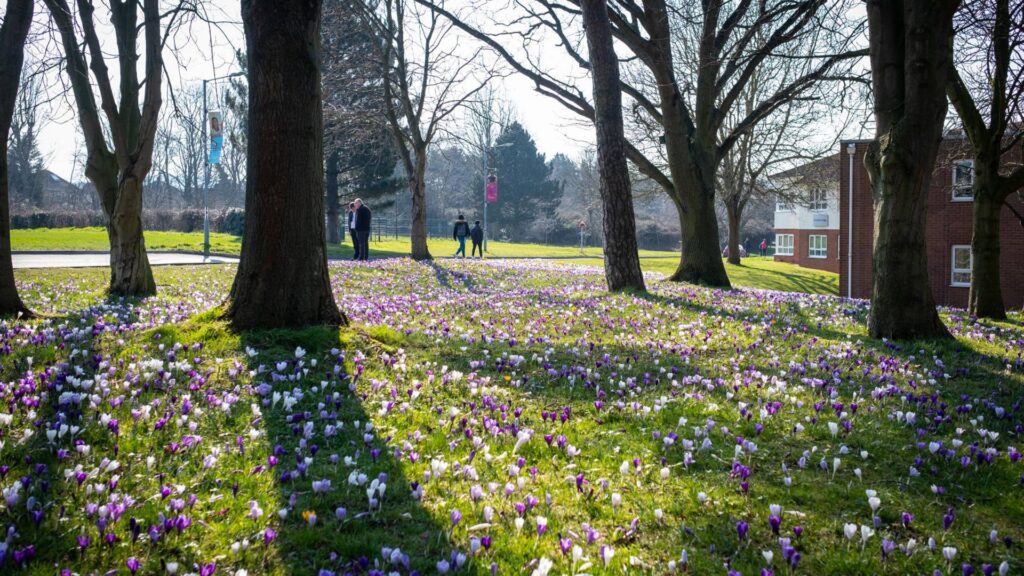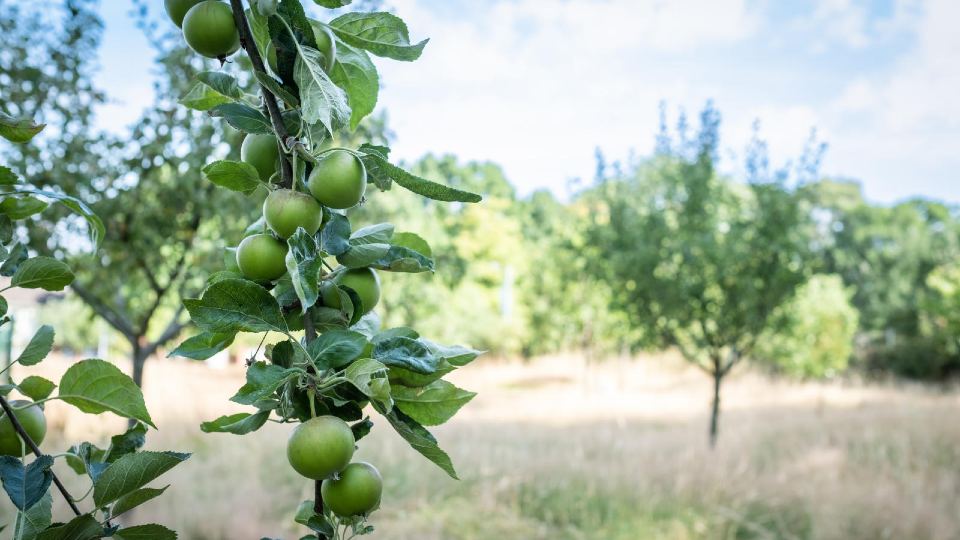Loughborough’s buzzing campus: the benefits of our blooming biodiversity

Loughborough is proud to have made huge strides in the 2024 QS World University Rankings: Sustainability, rising to 64th place out of 1,403 institutions.
In their first joint blog, the Vice-Chancellor Professor Nick Jennings and Visiting Member Dr Jo Jennings discuss the incredible biodiversity of the Loughborough campus and why it should be celebrated.
Buff-tailed, common carder and red-tailed cuckoo bumblebees…did you know that our campus is buzzing with nine different species of bumblebee including these varieties? We also have 17 species of butterfly, 45 bird species, 159 species of moth and some 15,000 trees[1]. By its very design, the outdoor environment is central to the day-to-day activities and experiences of so many of our staff and students – we play and watch sport in this space, enjoy recreational activities, and take lunch time walks. But how often do we stop to think about the wide variety of animals and plants we share the space with? Our campus is not only a place of academic learning but a ‘living lab’, with important work ongoing to survey and record biodiversity, maintain and increase green spaces and woodlands, and create new spaces rich in habitat and wildlife. As we understand and connect with this biodiverse environment, our appreciation of the campus can only be enhanced.
Given the campus is so central to our University’s identity, we need to treat it as a valuable resource. Currently 75% of our 523 acres is undeveloped. This will change as our ambitious strategy is delivered. But as the leader who currently has custodianship of our campus, Nick wanted to articulate the importance of nature in these plans. Jo has a life-long passion for the natural world, with a rural upbringing, a PhD and career in biological sciences, and long-standing work supporting biodiversity. So, after 30 years of marriage, we decided to bring these perspectives together in our first joint article.
Here we explore four important benefits of nature and a biodiverse environment – in provision, tackling climate change, sustenance, and supporting our cultural heritage. Benefits which are heightened as the environment becomes more biodiverse. We also discuss how we can maintain and protect the varied ecosystems of the Loughborough campus, which is something we are both passionate about.
In terms of provision, natural ecosystems supply food, water and raw materials, and can also be a source of natural compounds for new medicines. Environments like our Loughborough woodlands and streams, wetlands, rivers and riverbanks provide clean drinking water as well as purifying water through natural filtrations and mitigating floods. We are proud of our Fruit Routes project which supplies an autumnal abundance of fruit, berries and nuts from an enriched habitat of over 150 trees. These trees are planted in walkways which also provide blossom for pollinators and food sources for animals and birds, as well as locations for cultural activities and outdoor learning. Honey is harvested from the campus apiary and available to buy on campus as our very own ‘Loughborough Gold’.

Tackling the climate crisis is an urgent and global challenge and at an institutional level we are committed to addressing it and working toward net zero through research, innovation and education.
Biodiverse habitats provide a variety of ecosystems to act as carbon sinks, absorbing and storing carbon dioxide or locking carbon away below ground, enhancing natural resilience and improving soil health and fertility.
There are two ancient woodlands on the University campus – Burleigh Woods and Holywell – which date back over 900 years and support over 50 species of plants including a stunning bluebell display.

We have a direct descendent from Sir Issac Newton’s apple tree growing on campus, as well as the Cedar of Lebanon, which is nearly 200 years old and was part of the original estate. Planting new trees around the site will further support biodiverse habitats, provide shade and store carbon. Our researchers are looking into the effects of climate change on reservoirs, contaminants in freshwater systems, and nutrient cycling in soil and alongside this the University is driving its own campus decarbonisation plans to reduce emissions and meet the challenge of net zero.

Spending time outdoors and in natural environments sustains and restores us mentally and physically, resulting in improved wellbeing and life satisfaction. This recognised connection, termed biophilia (Wilson,1984), refers to the innate bond that humans have with nature, where we find places for exercise, recreation, relaxation and sport, leading to many health and social benefits. Studies show that being in green spaces can help reduce stress and anxiety and boost our immune system (National Academy for Social Prescribing) such that green social prescribing activities are now offered by the NHS.
In this vein, there are many walking routes to explore on the University campus, students run a popular hiking club, and there are regular Wellbeing Walks for staff to enjoy the woodlands and the outdoors, alongside conservation activities including coppicing and hazel fencing.
On Friday afternoons, the Landscaping and Gardening Society (LAGS) gather at the campus allotment to garden and grow fruit and vegetables, harvest produce and enjoy a chat over tea and shared food. Many who take part find that these activities provide a real sense of fulfilment alongside the positive physical and mental effects of gardening.
In terms of culture and heritage, the natural environment has important historical significance for communities, shaping cultural activities and building a sense of connectivity and identity.
We have a thriving artistic and creative community in our local area, who take inspiration from nature or seek to reconnect us with the natural environment (including our own Fruit Routes Artist Coordinator, Mita Solanky). Artistic expression is inspired by and connected to nature in all parts of the world, and preserving the natural environment is often closely linked to protecting cultural heritage and diversity. We can think of areas like the Lake District, inspiring poets and artists such as William Wordsworth and Beatrix Potter. At the University, poetry written by students and inspired by locations on campus, has been used for an audio walk to encourage everyone to engage with the outdoors. Locally, LU Arts, in partnership with the Charnwood Forest Geopark, is supporting artists to connect with the geologically unique environment to inspire their future artworks.
Having explored just some of the benefits of nature, let’s consider how universities like Loughborough are working to protect wildlife and natural habitats. The latest State of Nature 2023 report shows that the UK’s wildlife is continuing to decline, so there is much to be done and we have a part to play. We are a founding member of the Nature Positive Universities Alliance, a global network of over 500 universities across the globe that have pledged to preserve and restore ecosystems. As such, we are committed to measuring biodiversity and maintaining a green campus and sustainable landscape.
This substantial challenge to nature recovery includes a commitment to Biodiversity Net Gain and this new legislation requires an increase of at least 10% in the biodiversity value of a site when developing land. Alongside this sits the need to support our Local Nature Recovery Strategy which is designed to create a national network of wildlife rich habitats.
Our ongoing biosurveys have so far shown the campus to be home to a wide variety of insects, birds and animals, alongside fungi and flora. There are corridors of bat flight and sightings of the small muntjac deer. Signs of the rare Hornet Moth (Sesia apiformis) have been found in larval exit holes on the campus poplar trees, and our moth experts are carrying out surveys to record this species in new localities.

These biosurveys are important and form part of our baseline survey, alongside our Biodiversity Action Plan and Woodland Management Plan. All of this work enables us to identify current local species including rarer or endangered ones, and to monitor changes over time. By doing this, we can assess the impact of our activities as we develop the campus, and make informed land management decisions and choices about sustainability to ensure our biodiversity continues to grow.
We are ranked as one of the UK’s most wildlife-friendly universities. During May, we take part in the #NoMowMay campaign by Plantlife, refraining from mowing large areas of the campus to allow grass to grow, wildflowers to bloom and biodiversity to rebuild. This is followed by Let it Bloom June, where some grass areas are left undisturbed; the rekindled flowers – which recently included bee orchids for the first time – can be enjoyed across the campus, as well as attracting and increasing pollinators.

In concluding, we have argued that enhancing and preserving the rich habitat of our campus is crucial for the sustainability and resilience of our local and global communities. We understand the importance of biodiversity and our emerging sustainability strategy is integral to creating a place that is not just home to students and staff – but also a rich and diverse wildlife community.
We must cherish the bees and ensure we can all ‘feel the buzz’ of our vibrant, biodiverse campus. The natural environment – nature’s university – enables us to engage, connect, co-exist and learn, providing a source of knowledge and life lessons just like the University itself.
References
Wilson EO (1984) Biophilia: The Human Bond with Other Species. Harvard University Press, Cambridge, MA.
[1] This blog focuses predominantly on the East Midlands campus. For details of biodiversity initiatives on our London Campus see: Here East – Here East Planet
Vice-Chancellor's Communications
Opinions and comment from the Vice-Chancellor, Professor Nick Jennings

